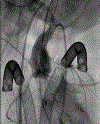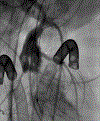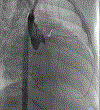Left main coronary artery stent placement in a 7.0 kg infant with Williams Syndrome
- PMID: 31259190
- PMCID: PMC6599618
- DOI: 10.12945/j.jshd.2019.001.18
Left main coronary artery stent placement in a 7.0 kg infant with Williams Syndrome
Abstract
We report the case of a 9-month-old male with Williams syndrome who underwent patch augmentation of supravalvar aortic stenosis and pulmonary artery stenosis, and required emergent drug-eluting left coronary artery stenting on post-operative day 1 for severe left ventricular dysfunction related to myocardial ischemia.
Keywords: coronary artery disease; percutaneous coronary intervention; williams syndrome.
Conflict of interest statement
Conflict of Interest: The authors have no financial conflicts of interest to disclose related to this case report.
Figures




References
Grants and funding
LinkOut - more resources
Full Text Sources
